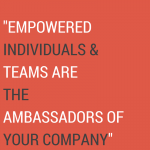Building a Learning Organization – Part 1
Have you ever been asked if your organization is a learning organization? Chances are probably not … most of the time learning is something put on the back-burner by organizations who are worried about profit margins and revenue growth.
In the past, employees focused on producing fast, making their actions uniform and essentially their positions replaceable. Today, people are the most powerful resources in an organization and can affect a company’s success rate. Think about if you have clients that are unhappy because their relationship manager isn’t putting them as the priority, what do you think that client’s going to tell other people in their industry about your company?
If people are the drivers of success, then what does a company do to drive that success? That’s where building a learning organization comes in. According to a Harvard Business Review article, a learning organization can be defined as “an organization made up of employees skilled at creating, acquiring, and transferring knowledge. These people could help their firms cultivate tolerance, foster open discussion, and think holistically and systemically.”
Becoming a learning organization starts at the top. Leaders must buy into the fact that learning and knowledge advancement is fostered not only by articulating a vision, adding benefits, and/or providing training, but it is cultivated in three additional ways: engaging employees, empowering teams, and innovating firm-wide.
Engaged Employees Dale Carnegie once said, “an organization’s greatest asset is its people, but in reality, this is only true when employees are fully engaged with their jobs.” Employee engagement is the emotional and functional commitment an employee has to his or her organization. In a recent survey of 1,500 employees in the United States by Carnegie Training, 71 percent of all employees are not fully engaged. However, companies with engaged employees outperform those without by up to 202 percent.
How do companies drive employee engagement? In four ways:
- Cultivating Relationships – specifically the relationship with the employee’s immediate supervisor. Numerous studies show that the attitude and actions of the supervisor can enhance engagement.
- Fostering an Environment of Open Communication with Leadership – employees want leaders that actively listen and take their input to lead the company in the right direction while communicating vision, strategy, and goals.
- Creating Company Pride in the Workforce – An organization that cares about how the employee feels is an organization that gives back to the overall well-being and emotional health of the employee.
- Enhancing the Knowledge of Each Employee – fostering a learning environment as it relates to the individual’s position, goals and development can help employees find the level of engagement that is needed.
Coming tomorrow – part 2 of this 3 part series. Stay tuned!
Emily Traxler, Chief Marketing Officer, Director, has been with First Rate since 2010. In her role she manages the Marketing team to expand awareness of the First Rate brand, fill a robust sales pipeline and maintain a positive image of First Rate and its products and services. Outside of First Rate Emily is an advocate for Jessica Glenn’s Special Spaces DFW changing lives one bedroom at a time.






